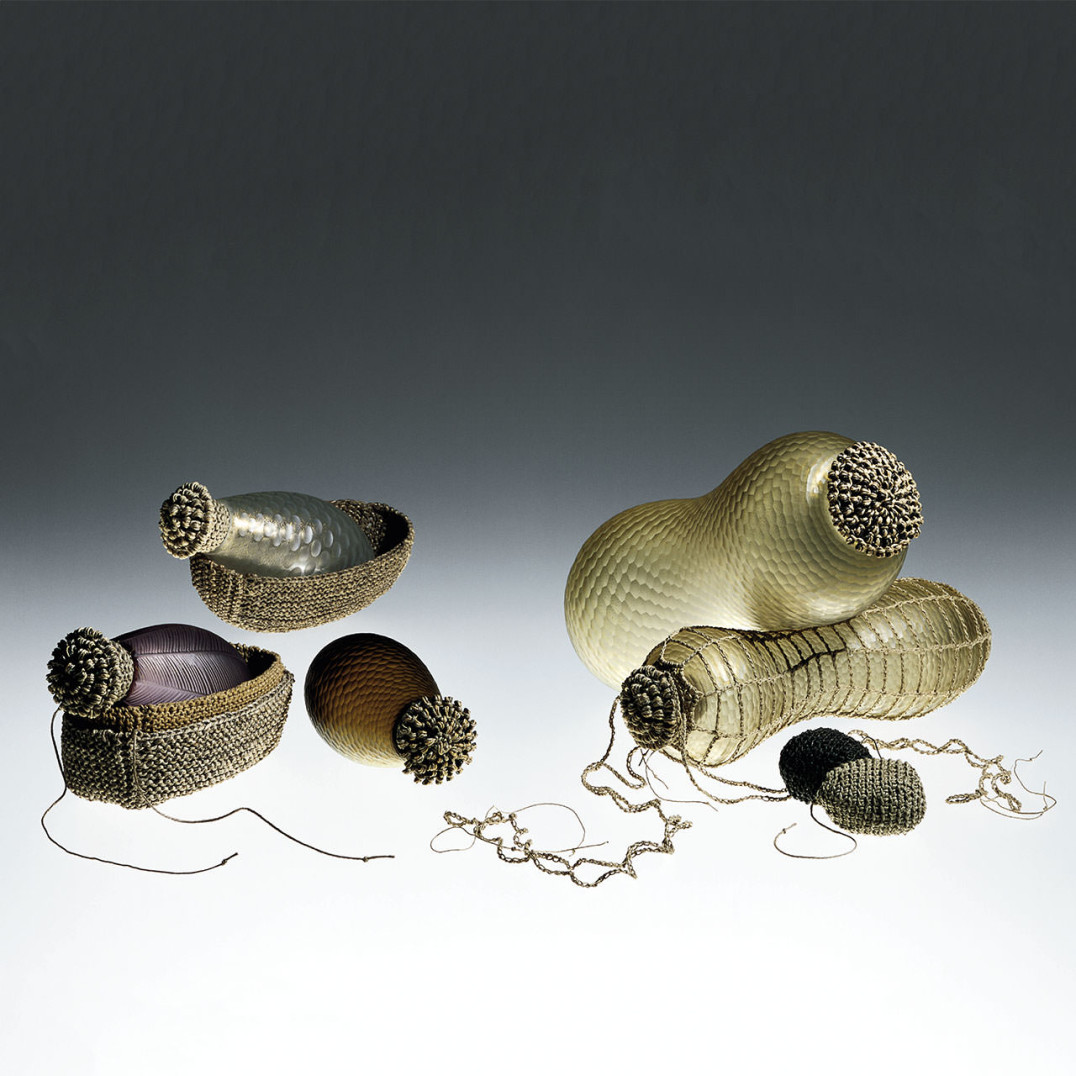
Cristiano BianchinNidi, semi e fusi, 1996

Cristiano BianchinNidi, semi e fusi
A grouping of five nidi, semi, and fusi resting in or among baskets. All glass pieces are transparent aubergine, clear, or straw colored. The surfaces are battuto with applied gold leaf throughout. The corolle, baskets, and other elements are handwoven in hemp by the artist.
8 in. long (20.3 cm)
8 in. long (20.3 cm)
8 in. long (20.3 cm)
13 in. long (33 cm)
13 in. long (33 cm)
Exhibitions:
1996, Venice, Venezia Aperto Vetro;
1998, Venice, Venezia Aperto Vetro;
2000, New York, Venetian Glass, Museum of Arts & Design;
2001, Milan, Murano: Vetri dalla Collezione Olnick Spanu, Spazio Oberdan.
Bibliography and comparative texts:
International New Glass, 1996, p. 101; International New Glass, 1998, p. 59;
New tradition…, 1998, pp. 28-33; Olnick Spanu, 2000, n. 163;
Olnick Spanu, 2001, n. 199; D. Klein, 2001, p. 31.

Cristiano Bianchin 1963–
Born in Venice, where he lives and works, Cristiano Bianchin attended the Accademia di Belle Arti di Venezia, where he studied under the direction of the renowned artist Emilio Vedova and graduated with a degree in painting in 1987. Since 1984, he has exhibited at public institutions and private galleries, and his first personal show was held at the Galleria Bevilacqua La Masa in 1987. As an emerging artist, Bianchin conceives his own artistic language as a reading of experimental poetics involving the possible exchange between the sensuality of seeing and the materials used in art. His first experiments in glass date from 1992 and have been presented in numerous collective and personal exhibitions, such as the one held in 1995 at the Museo Antonio Canova (also known as the Possagno) near Treviso. Bianchin views his work with glass as having an evolutionary continuity based on the classical validity of glassworking techniques, which he confronts with the experimentation of new sculptural forms. His Nidi date from 1996: they are works conceived as mineral architectures whose surface is textured using the refined Murano glass techniques of battitura and molatura. Between 1998 and 1999, he created his Riposapesi, in which the blown glass pieces, black or vividly colored, are synthetically austere. Bianchin was selected in 1995 and 1997 as the Italian artist at the Corning Museum of Glass in New York. He participated at Aperto Vetro, the International Exhibition of Contemporary Glass in Venice, in 1996 and 1998.
Cristiano BianchinNidi, semi e fusi, 1996
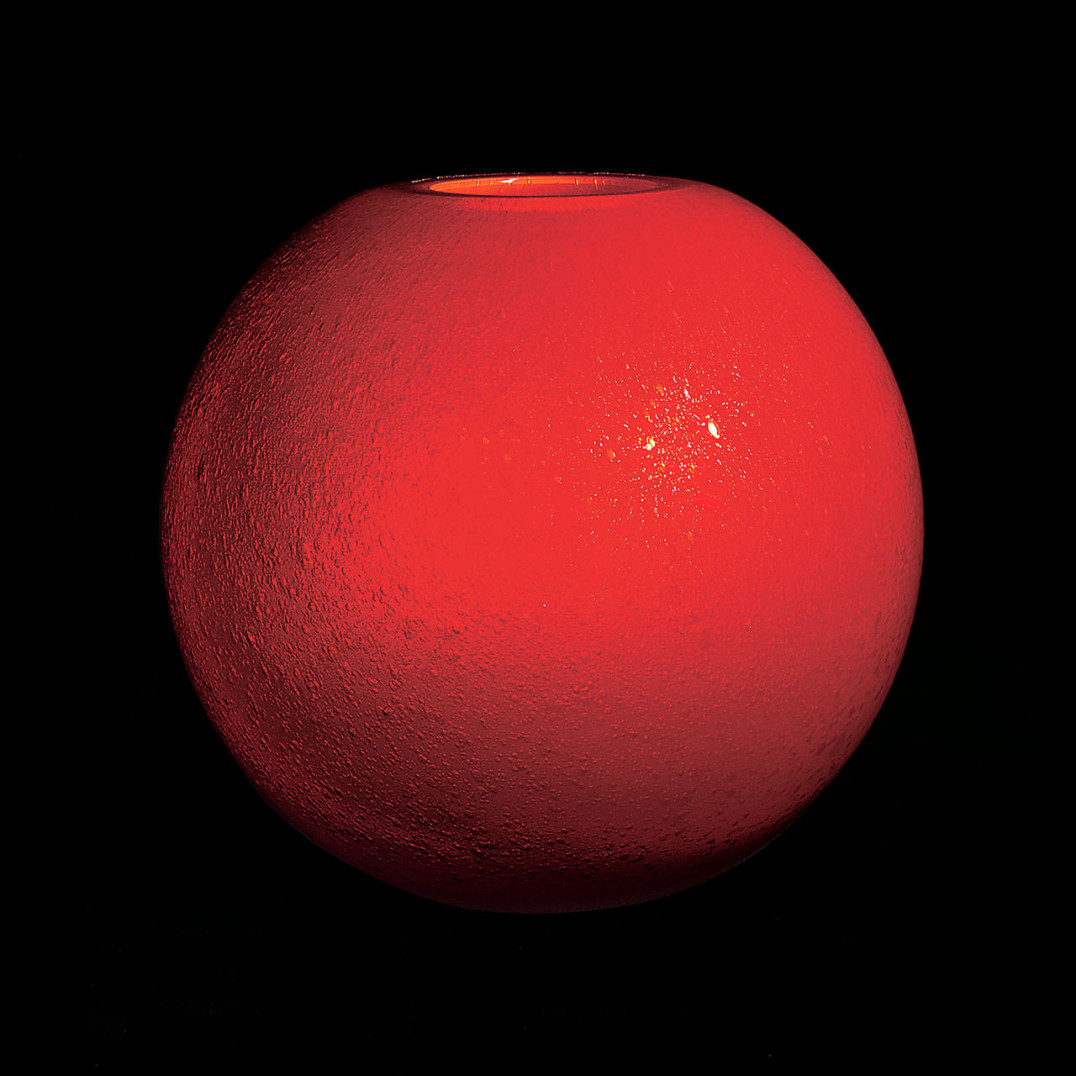
Gae AulentiSfera, 1999
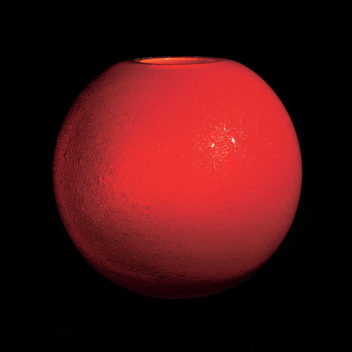
Gae AulentiSferaVenini & C., 1999
Vase from the Millennium III collection in red pulegoso glass.
The vase was crafted by Venini in
a limited edition (99 pieces) to celebrate the 3rd millennium.
Engraved: venini Millennium III 7/99 gae aulenti.
10 5/8 in. high (27 cm)
Collection of the Museum of Arts and Design, New York, Gift of Nancy Olnick and Giorgio Spanu
Exhibitions:
2001, Milan, Murano: Vetri dalla Collezione Olnick Spanu, Spazio Oberdan.
Bibliography and comparative texts:
M. Romanelli, 2000, p. 67;
Olnick Spanu, 2001, n. 198.

Gae Aulenti 1927–2012
Born in Palazzolo dello Stella (Udine), Gae Aulenti graduated in architecture at the Politecnico in Milan in 1953. From 1955 to 1963, she was the editor of Casabella magazine. She worked prevalently in the field of architecture and was responsible for significant museum renovations such as the transformation of the Gare d'Orsay into the Musée d'Orsay in Paris (1980-1987), the new exhibition design for the Musée d'Art Moderne of the Centre Pompidou in Paris (1982), the renovation of Palazzo Grassi in Venice (1986), and the restoration of the Catalan Museum in Barcelona. Her later works include the renovation of the Spazio Oberdan in Milan, where she also designed the renovation of Piazzale Cadorna. She designed showrooms for Fiat and Olivetti, as well as theatre productions. Since the late '50s, she had also taken an interest in product design, producing a variety of objects, mostly furniture and lamps, for companies such as Poltronova, Knoll, Zanotta, Fontana Arte, and Venini.

Venini & C. 1932–2001
In 1932, when both Martinuzzi and Zecchin left the company, Paolo Venini changed the name from Vetri Soffiati Muranesi Venini & Co. (V.S.M. Venini & Co.) to Venini & C.. Milanese architect Tommaso Buzzi became the new artistic director. After 1934, artistic direction was taken on by Carlo Scarpa, who designed most of the company's production through 1947. Side by side with Venini, who often intervened personally in design, Scarpa created numerous collections of objects characterized by refined colors. After World War II, Venini & C. sought numerous collaborations with artists such as architect Giò Ponti and the Swedish-born Tyra Lundgren. After 1948, Fulvio Bianconi, Massimo Vignelli, and Tobia Scarpa contributed significantly to the new direction of the company. Paolo Venini died in 1959 and his son-in-law, Ludovico Diaz de Santillana, took over the management of Venini & C. He not only worked personally as a glass designer but also continued the collaboration started by Paolo Venini with various artists and designers. Starting in 1960, many other designers collaborated with the company, like Thomas Stearns, Toni Zuccheri, Tapio Wirkkala, Laura and Alessandro Diaz de Santillana, James Carpenter, Dan Dailey, Richard Marquis, Benjamin Moore, and Toots Zynsky. In 1986, the de Santillana family left the company, selling their stock to the Ferruzzi group, which guaranteed the fine quality Venini was known for by hiring new designers such as Timo Sarpaneva, Marco Zanini, Ettore Sottsass Jr., Alessandro Mendini, Mario Bellini, Barbara del Vicario, and others. In 1988, Venini was acquired by Royal Scandinavian. Since 2001, Venini S.p.A. has been part of Italian Luxury Industries Group and is led by Giancarlo Chimento, Giuliano Tabacchi, and Giorgio Rizzo.
Gae AulentiSfera, 1999

Franca HelgFranco AlbiniAnemone, 1971
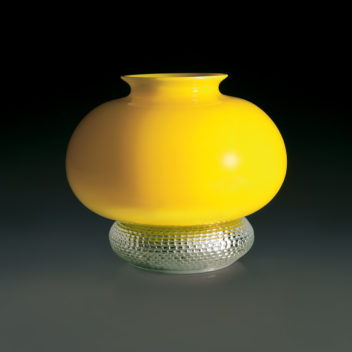
Franca HelgFranco AlbiniAnemoneSalviati & C., 1971
Vase in cristallo glass cased in yellow glass. It is part of a series of vases designed by Albini and Helg for San Lorenzo S.r.l. in Milan in the Anemone, Fresia, Forsizia variations.
Engraved: Salviati per San Lorenzo Albini-Helg.
5 3/4 in, high. (14.6 cm)
Exhibitions:
1972, Vienna, Industrial Design
aus Italien;
2001, Milan, Murano: Vetri dalla Collezione Olnick Spanu, Spazio Oberdan.
Bibliography and comparative texts:
Industrial Design…, 1972, p. 34;
Olnick Spanu, 2001, n. 197.
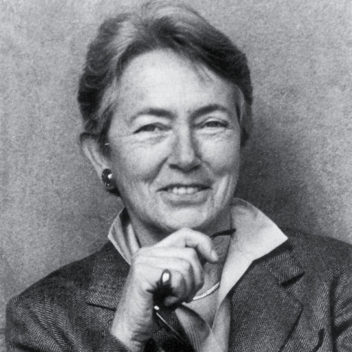
Franca Helg 1920–1989
Franca Helg was born in Milan on February 21, 1920. She graduated from the Architecture School at the Politecnico in Milan in 1945. Her professional career, which she began independently, collaborating with Franco Albini after 1951, with Antonio Piva after 1962, and with Marco Albini after 1965, embraces the entire range of design work. She was a tenured professor of Architectural Composition III in the Architecture Department of the Politecnico in Milan. She held classes in architectural design at the Technische Universität in Munich and at the Catholic University of Córdoba in Argentina, and specialization seminars in Cuzco, Peru, in Quito, Ecuador, in Bogotà, Colombia, in Salvador de Bahia, Brasil, in Madrid, and in Barcelona. She lectured at conferences in Italy and abroad, and was a member of competition juries and evaluation committees in Europe and overseas.

Franco Albini 1905–1977
Franco Albini was born in Robbiate (Como). He graduated with a degree in architecture from the Politecnico in Milan in 1929. The following year, he opened his own architecture studio, concentrating on product and exhibition design, and becoming one of the world's most significant designers in this field during the course of his career. In 1945 and 1946, he directed the architectural review Casabella, and between 1949 and 1977, he turned to teaching, first at the universities in Venice and Turin until 1963, then at the Politecnico in Milan. His works are characterized by a rational severity, which is evident in works such as the renovation and interior design of the Palazzo Bianco in Genoa (1950), the design for the display of the Treasure of San Lorenzo in Genoa (1952) in collaboration with Franca Helg, and the restoration of the Palazzo Rosso in Genoa (1952-1961). His successful work in the field of design is noted for the essential elegance which distinguishes his many furniture projects, such as the Margherita armchair for Bonacina (1950), the Fiorenza armchair for Artflex (1952), the Luisa chair for Poggi (1954), and the Credenza (1967) designed in collaboration with Franca Helg. This partnership also produced the collection of glass pieces designed for San Lorenzo S.r.l. and crafted by Salviati. In the early '60s, in collaboration with Franca Helg and Bob Noorda, he designed the stations' furnishings and signage for Milan's Subway Line 1.
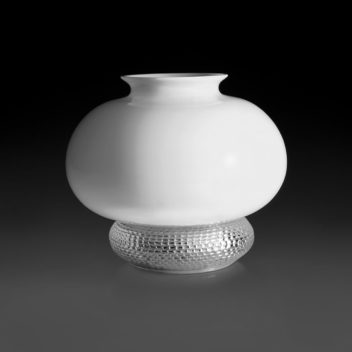
Salviati & C. 1877–
In 1859, Antonio Salviati, a lawyer, founded the “Salviati Dott. Antonio fu Bartolomeo” furnaces. With the help of Lorenzo Radi and Enrico Pondio, he developed a new method of making mosaic with glass. The mosaic tesserae that decorate the dome of St. Paul’s Cathedral and the Hall of the House of Parliament in London, the Opera Theatre in Paris, and many others were made by Salviati. In 1877, Salviati founded Salviati & C. in Murano, employing some of the best glass masters operating at that time: Antonio Camozzo and the talented Giovanni, Giuseppe, Benvenuto and Benedetto Barovier. They created a collection of glasses, stemware, bowls, chandeliers and vases, and a range of etched pieces. Salviati, who was known for his innovation, is recognized for the rediscovery of the avventurina, a fiamma, and opalino types of glass. Antonio Salviati died in 1890 and at the beginning of the 20th century the company became property of Maurizio Camerino, a young glassmaker who had started his craft at Salviati & C. During the 1930s, the Camerino family decided to abandon the production of mosaic to focus on the making of decorative objects and lighting. In the 1950s, with Luciano Gaspari as the new artistic director of Salviati & C., the company developed frequent collaborations with architects such as Sergio Asti, Romano Chirivi, and Vinicio Vianello, as well as with international designers such as Heinz Oestergaard and Claire Falkenstein. Today, Salviati remains one of the most representative companies for glassmaking in the world and continues to establish collaborations with many inspiring designers.
Franca HelgFranco AlbiniAnemone, 1971

Marco ZaniniAlpha Centauri, 1982

Marco ZaniniAlpha CentauriToso Vetri d'Arte, 1982
Vessel with elements in turquoise, cristallo, and red trasparente glass.
Engraved: Memphis MADE IN ITALY by Toso Vetri d’Arte.
15 9/16 in high (39.5 cm)
Exhibitions:
2001, Milan, Murano: Vetri dalla Collezione Olnick Spanu, Spazio Oberdan.
Bibliography and comparative texts:
Memphis…, n. 62;
Olnick Spanu, 2001, n. 196.
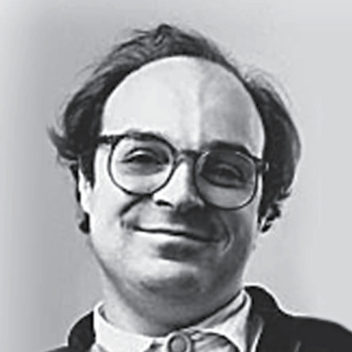
Marco Zanini 1954–
Born in Trent, Zanini graduated with a degree in architecture from the Università di Firenze and later took several courses at the Architectural Association in London. From 1975 to 1977 he traveled through Mexico, Canada, and the United States, where he worked briefly. At the end of 1977, he returned to Italy and settled in Milan where he began working with Ettore Sottsass. He became a partner in the Studio Sottsass Associati in 1980, and in 1981 was a founding member of the Memphis Group, in which he participated actively through 1988. He showed in several exhibitions with Memphis, designing ceramics, lighting systems, furniture, and several series of glass objects crafted by the Vetreria Toso Vetri d'Arte. He collaborated with Studio Sottsass Associati on many projects such as office furniture for Knoll International, exhibition designs and interiors, urban furniture, and industrial design objects. Independently, he designs and makes jewelry, ceramics, furniture, and blown glass objects (Venini, 1989).
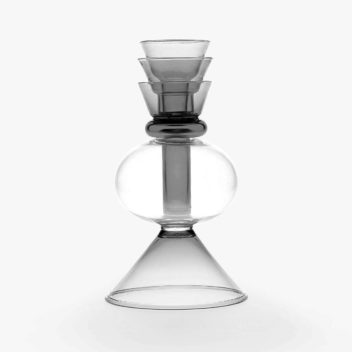
Toso Vetri d'Arte 1981–1990
Toso Vetri d'Arte was established in 1980 by Luigi Toso and three glass-blowing maestri: Carlo Tosi "Caramea", Dino Toso, and Luigi Visentin. Tosi had worked on Murano for over 30 years and was renowned for his particular skill in goblets. Other designers and collaborators included Fulvio Bianconi, Marco Zanini and Ettore Sottsass, who, in 1981, founded the Memphis Group. Toso Vetri d'Arte produced glass for the Memphis Group from 1981 to 1990. In 1990, Toso Vetri d'Arte was bought out by Andrea Boscaro and renamed Compagnia Vetreria Muranese.
Marco ZaniniAlpha Centauri, 1982
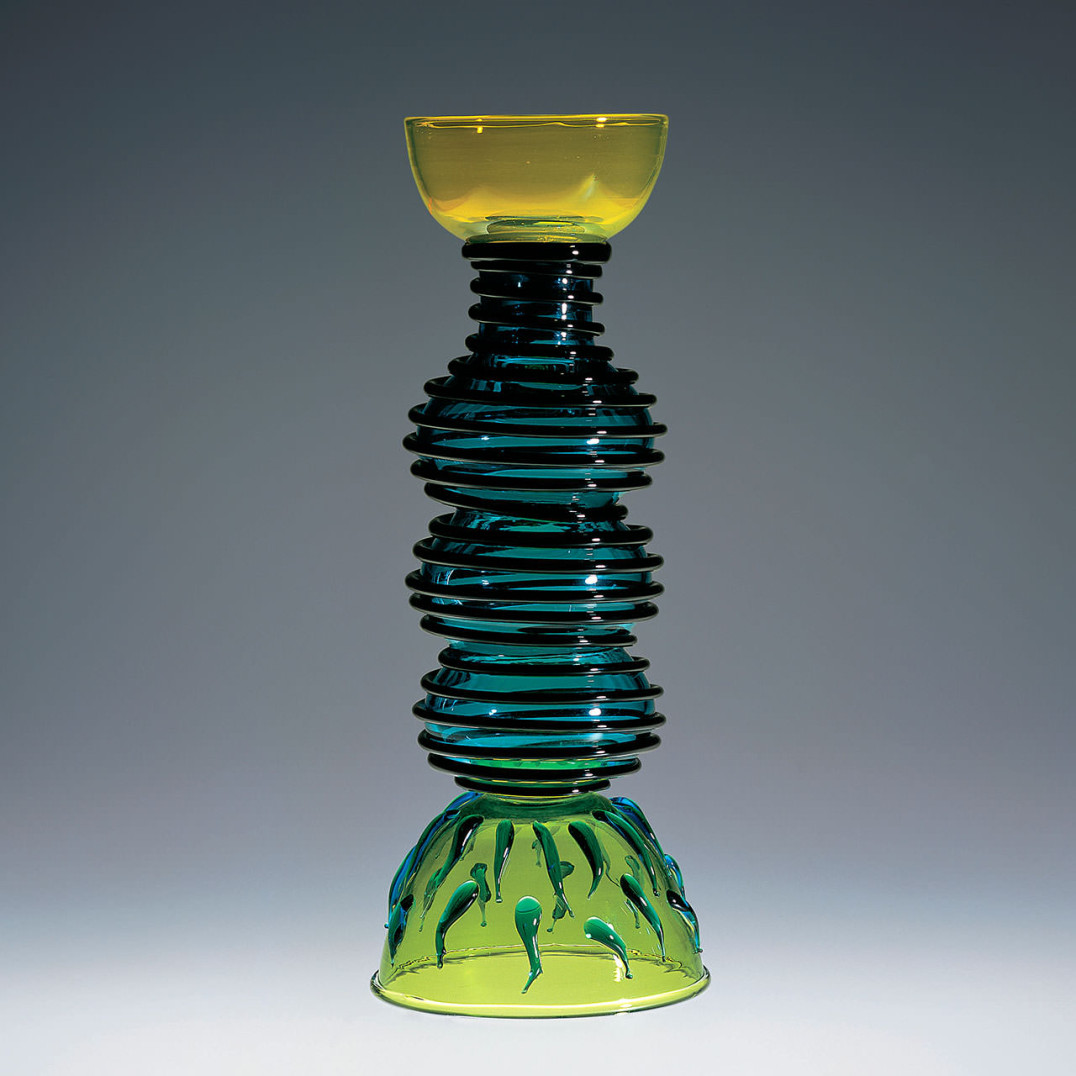
Ettore SottsassAlioth, 1983
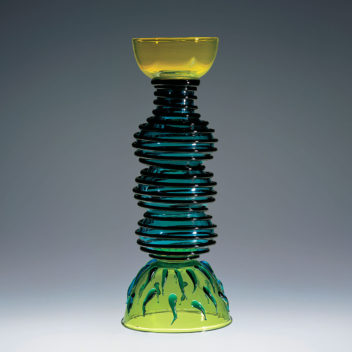
Ettore SottsassAliothToso Vetri d'Arte, 1983
Vessel with elements in turquoise and yellow trasparent glass with applications of multicolored glass.
Engraved: E. Sottsass.
18 in. high (45.7 cm)
Exhibitions:
2001, Milan, Murano: Vetri dalla Collezione Olnick Spanu, Spazio Oberdan.
Bibliography and comparative texts:
Memphis…, n. 64;
M. Barovier, B. Bischofberger,
M. Carboni, 1998, p. 25;
M. Barovier, 1999, p. 311;
Olnick Spanu, 2001, n. 195.
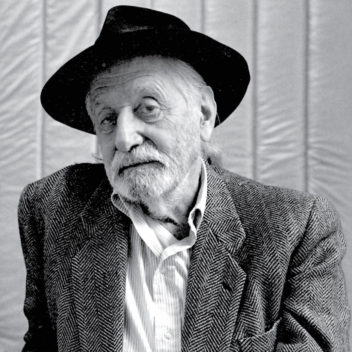
Ettore Sottsass 1917–2007
Born in Innsbruck, Austria, Ettore Sottsass graduated in architecture at the Turin Politecnico in 1939. In 1946 he settled in Milan and began to work in graphics and illustration. A few years later he opened his own studio. From 1949 to 1954 he designed and built several public housing projects in Turin. He was invited to participate in several editions of the Triennale. In 1958, he became a consultant for Poltronova and Olivetti, the company for which he designed the first Italian calculator, Elea 9003, which won him one of the four Compasso d'Oro awards (1959 edition) he collected during his twenty-year collaboration with the company. For Olivetti he designed office machines and typewriters such as Praxis, Tekne, and Valentine, objects whose design quality put them into the permanent collections of museums such as the Museum of Modern Art in New York and the Centre Pompidou in Paris. In 1981, he opened the Studio Sottsass Associati, working in the fields of architecture, graphics, and industrial design. Together with Marco Zanini, he founded the Memphis Group, which pursues its objective of creating a radical iconographical update in figurative language. For Memphis, Sottsass designed furniture, lamps, and accessories, including a series of multicolored glass pieces made of elements crafted by Toso Vetri d'Arte (1982-1986). His preceding experience with glass dated back to 1974, when he designed a series of objects for Vetreria Vistosi. His interest in glass led him to design several pieces for Venini in the '90s and several limited series of works in glass for the Galleria Marina Barovier.

Toso Vetri d'Arte 1981–1990
Toso Vetri d'Arte was established in 1980 by Luigi Toso and three glass-blowing maestri: Carlo Tosi "Caramea", Dino Toso, and Luigi Visentin. Tosi had worked on Murano for over 30 years and was renowned for his particular skill in goblets. Other designers and collaborators included Fulvio Bianconi, Marco Zanini and Ettore Sottsass, who, in 1981, founded the Memphis Group. Toso Vetri d'Arte produced glass for the Memphis Group from 1981 to 1990. In 1990, Toso Vetri d'Arte was bought out by Andrea Boscaro and renamed Compagnia Vetreria Muranese.